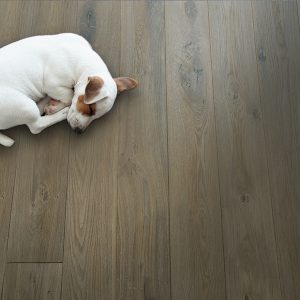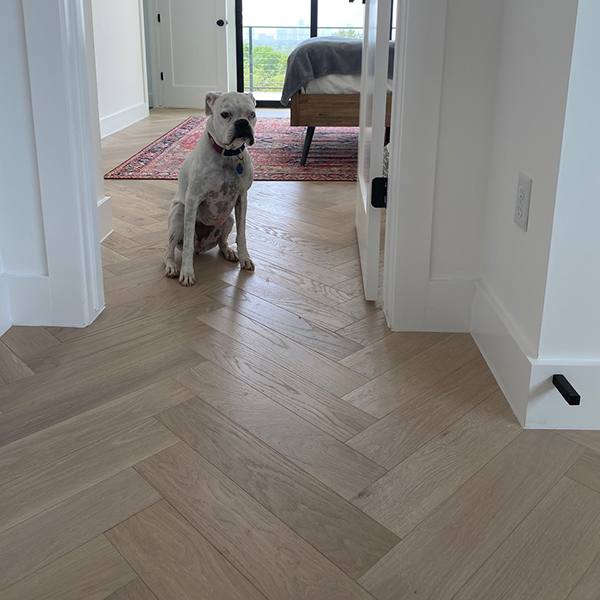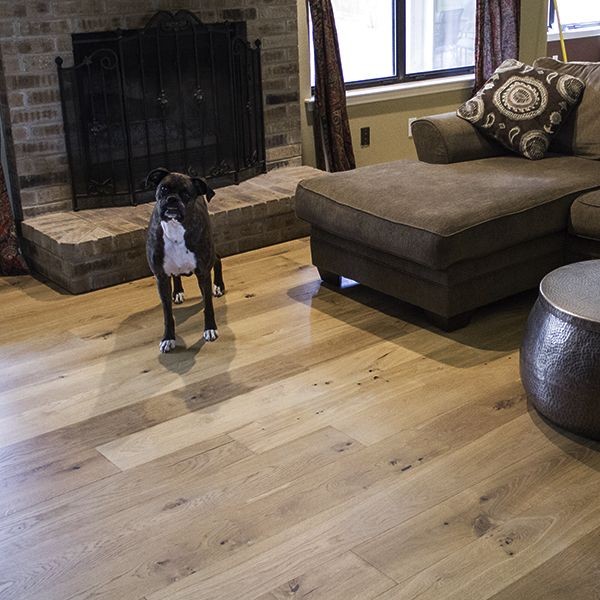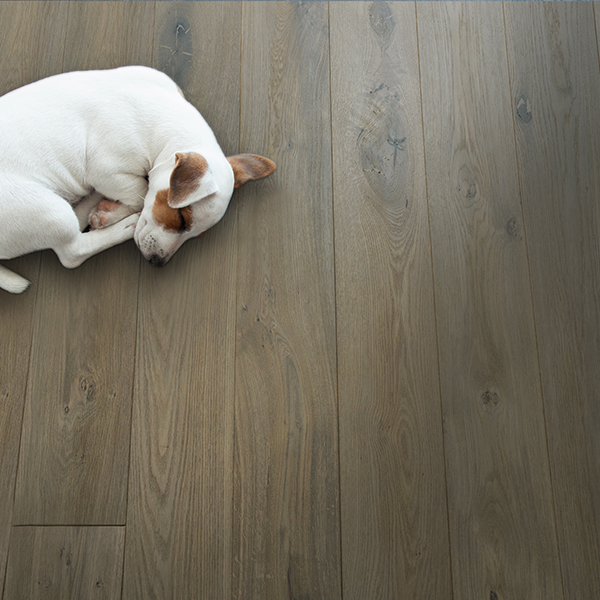
It’s been a difficult year and a half, and let’s be honest, you’ve been staying inside a lot more than usual lately. Lots of people have been coping with the extra stress by adopting a loving canine companion for extra kisses and cuddles.
But now, you’re thinking about putting in some new flooring, and it’s got you thinking that cute puppy might not be so cute when they’re scratching up your hardwood floors. There are other options, such as vinyl, laminate, tile, and stone, but most homeowners enjoy the look and feel of hardwood floors and worry that owning a dog is enough to stop them from putting in the flooring of their dreams.
Well, lucky for you, hardwood floors are actually a great choice for pet owners! They’re easy to clean and don’t trap your pooch’s shedding and dander. Unfortunately, that doesn’t mean there’s nothing to worry about, though. So, let’s explore the world of having your dream floors and your furry friend too!
Teach An Old Dog New Tricks

Dogs have long claws that can’t be retracted, and when they come back from a walk, they usually forget to wipe their paws at the door. All of that dirt and grime can really cause some problems for your shiny new floors. That dirt acts as an abrasive on your floors and can dull the shine.
Not to mention potty-training. If your puppy has an accident on your hardwood floors, it’s essential to clean it up immediately. That’s common sense anyway, but pet urine can discolor your wood floors, and any standing water left for a long time can cause the wood to warp and possibly crack.
Similarly, make sure to trim your pup’s nails on a regular basis and discourage them from running indoors. Do you have larger dogs? If so, they can cause some fairly deep gouges in your floors if their nails are left untrimmed. Some owners go even further and keep their doggies in adorable booties, but we know that’s not for everyone.
As a general note, we do not support or recommend declawing your pets. Most veterinarians and animal adoption agencies will counsel you specifically about how harmful the declawing process is. If you’re very worried about your wood floors, it’s always best to consider alternatives such as entry and area rugs, hallway runners, or using a doggie gate to keep your pets out of certain rooms.
So, let’s focus on the ways to have your cake and eat it too – thus, a way to have pets and beautiful flooring too!
Choose Your Territory Wisely

All hardwood is not created equal. Some types of hardwood are actually more durable than others. When thinking about installing wood floors, your aesthetic and budget are important factors, but you should absolutely keep your pet’s needs in mind. You can train your puppy to the ends of the earth and back, but there are certain accommodations that can’t be avoided. Most species of hardwood and their finishes can tolerate scratches, but, over time, a dog’s claws can cause major divots and gouges.
Have you heard of the Janka Hardness Scale? It rates the hardness of a given wood by assigning each wood a rating from 0 to 3,000, with 0 as the softest and 3,000 as the hardest. This hardness is a test of how well the wood stands up to dents and normal wear and tear. The test itself actually measures the force necessary to move a steel ball a measured distance into the given wood sample. For example, on the scale, the hardest woods are Songwood and Strand Woven Eucalyptus, while the softest are Walnut and Hevea.
In general, depending on how many people regularly walk through your house and their level of activity, a Janka rating of 1,000 or higher is considered acceptable. In rooms where you expect company or a higher level of foot traffic, you should always consider using a harder wood to prevent any scratches or dents when people forget or neglect to take their shoes off.
Throw Your Home A Bone

Brazilian wood ranks as one of the hardest on the Janka Hardness Scale, which means that Brazilian Cherry wood is much harder than similar woods from other parts of the world. Brazilian wood ranges in brownish-red tones, often with sleek black streaks that darken over time. It’s also made in both solid wood and engineered wood planks, depending on what you want to install. However, keep in mind that engineered wood flooring can only be sanded down so many times as compared to solid wood flooring. Sanding down your floors periodically restores the shiny newness from when it was first installed and gets rid of the surface scratches from your pooch.
Both options are very durable and hold up to the wear and tear of a puppy’s romps. Also, from Brazil is Ipe, or Brazilian walnut, which is so hard that it is used on outdoor decks! If it’s hard enough for the great outdoors, we believe it can definitely stand up to your dog’s toenails, right?
Another great option is Acacia wood. It’s one of the most popular flooring choices at the moment, and it’s not likely to fall out of fashion. It has wonderfully distinctive grain patterns and a variety of colors to choose from. With an extremely high rating on the Janka Hardness Scale, it can handle the everyday scratches and skids from Fido or children. Although it is typically pricier than many options, the extreme durability makes the extra cost worth it when accounting for pets.
Both Brazilian and Acacia are great choices for pet owners because they have an intense hardness that prevents the occasional untrimmed nail or scratch from actually penetrating the finish and leaving a long-lasting mark. At the other end of the scale, pine and fir ought to be avoided in homes with pets because they are much softer woods. In fact, any wood that ranks under 1200 on the Janka Hardness Scale is likely not a great idea for a pet-friendly household.
If you’re looking for something even more durable, consider strand woven flooring species. They’re made using a high-pressure manufacturing process, which means they are rated highly on the Janka scale. The strands are interwoven with hard resin and are not only incredibly tough but good for the environment as well since they’re made using renewable resources.
The Finishing Touch
Additionally, look for wood floors that are pre-finished, sealed, and stained in the factory so that they have multiple layers of aluminum oxide urethane to protect them from Fido’s claws.
Alternatives
If you’re looking for something a little more unusual but still in the wood family, consider bamboo! Although it’s actually a grass and not a wood, it is rated and sold as wood. It’s rated extremely high on the Janka scale, and it stays warm in the winter.
Besides wood flooring, you also have other options for durable flooring that can stand up to your dog’s nails at every turn. Vinyl flooring is cool in the summer and warm in the winter, along with being very affordable. Luxury vinyl flooring is even more resilient and recommended by the American Kennel Club as great flooring for your pets. Laminate flooring rated AC 3 is dog-friendly and very resistant to accidental scratches.
Although carpet is soft and your pets will love its plush feel, be wary of installing carpet in a pet-friendly home. Any accidents will be difficult to clean up, and stains seep in easily. Not to mention how their claws will shred the fibers over time.
It’s no secret that when you have furry members of the family, they affect your flooring choices. So, just be aware of the Janka scale, and make sure you select flooring that meshes with both their paws and with your decorative tastes!
Sources
https://www.thespruce.com/best-wood-floors-for-dogs-1821864
https://www.thespruce.com/best-floors-for-dogs-4045349
https://www.thespruce.com/pet-friendly-living-room-floors-1315040
